Blue Foot Baboon Tarantula
- March 12, 2024
- 0 comment
The Blue Foot Baboon Tarantula, scientifically known as Idiothele mira, is a fascinating arachnid species renowned for its striking appearance and intriguing behavior. Native to the rainforests of Mozambique, this tarantula species stands out due to its velvety black body adorned with vibrant blue legs, hence its distinctive name. These tarantulas are known for their solitary nature, preferring to inhabit burrows in the forest floor, which they line with silk for protection and insulation.
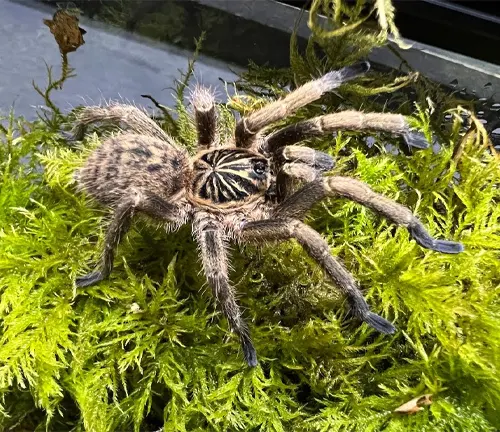
Despite their intimidating appearance, Blue Foot Baboon Tarantulas are generally docile creatures, rarely exhibiting aggression unless provoked. They primarily feed on insects and play a crucial role in controlling pest populations in their natural habitat. Due to their unique characteristics and relative ease of care, they have gained popularity among exotic pet enthusiasts, although they require specific housing and care requirements to thrive in captivity. Overall, the Blue Foot Baboon Tarantula exemplifies the diversity and wonder of the natural world, captivating the imaginations of people worldwide with its beauty and behavior.
| Aspect | Description |
|---|---|
| Scientific Name | Idiothele mira |
| Common Name | Blue Foot Baboon Tarantula |
| Native Habitat | Rainforests of Mozambique |
| Body Color | Velvety black |
| Leg Color | Vibrant blue |
| Size | Up to 6 inches in leg span (females are larger) |
| Behavior | Solitary, docile unless provoked |
| Diet | Insects, primarily crickets, roaches, and beetles |
| Habitat | Burrows in forest floor, lined with silk |
| Conservation Status | Not currently listed as endangered, but faces threats |
| Role in Ecosystem | Controls insect populations, maintains ecosystem balance |
| Popular as Pet | Yes, among exotic pet enthusiasts |
Exploring the Fascinating World of Idiothele Mira
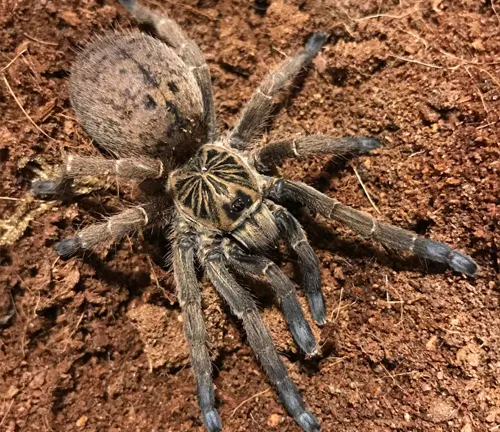
The Blue Foot Baboon Tarantula, scientifically known as Idiothele mira, is a captivating arachnid species renowned for its striking appearance and intriguing behavior. Native to the rainforests of Mozambique, this species has captured the fascination of arachnid enthusiasts worldwide. In this article, we delve into the world of the Blue Foot Baboon Tarantula, exploring its physical characteristics, habitat, behavior, significance, and more.
Physical Characteristics
Here are the physical characteristics of the Blue Foot Baboon Tarantula:
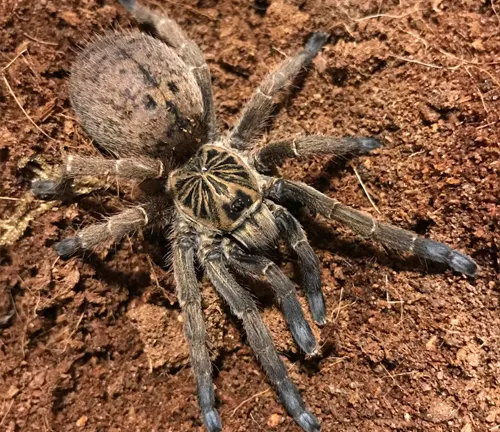
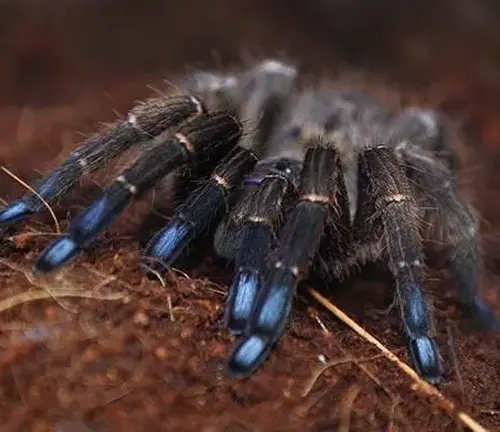
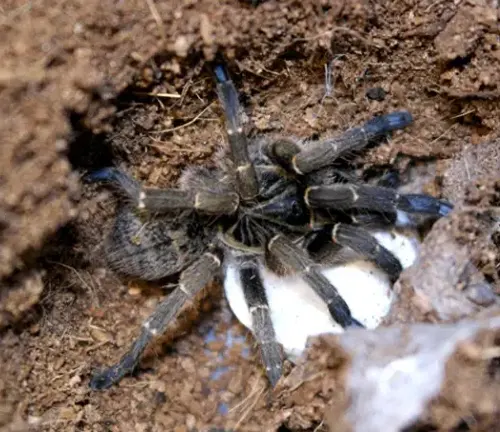
- Body Color: The Blue Foot Baboon Tarantula typically has a velvety black body, which serves as a stark contrast to its vibrant blue legs. This combination of colors gives the tarantula its distinctive appearance.
- Leg Color: One of the most striking features of the Blue Foot Baboon Tarantula is its vibrant blue legs. The intense blue coloration is a notable characteristic that sets this species apart from other tarantulas.
- Size: Blue Foot Baboon Tarantulas exhibit sexual dimorphism, with females being larger and more robust than males. Adult females can reach sizes of up to 6 inches in leg span, while males are typically smaller.
- Body Structure: These tarantulas have a compact and sturdy body structure, with a cephalothorax (head and thorax combined) that is covered in short, dense hairs. The abdomen is typically rounded and adorned with similar hairs.
- Hairiness: Blue Foot Baboon Tarantulas are covered in fine, short hairs, giving them a soft and fuzzy texture. These hairs serve various purposes, including sensory perception, insulation, and protection against predators.
- Venomous Fangs: Like all tarantulas, Blue Foot Baboon Tarantulas possess venomous fangs used to subdue their prey. However, their venom is relatively mild and not considered harmful to humans.
- Eyes: Blue Foot Baboon Tarantulas have eight eyes arranged in two rows on the front of their cephalothorax. While they have poor eyesight and primarily rely on touch and vibration to detect prey, their eyes can detect movement and light changes.
Habitat and Distribution
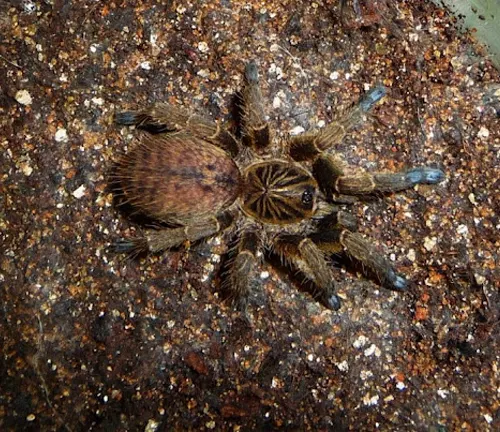

The Blue Foot Baboon Tarantula is predominantly found in the lush rainforests of Mozambique, a country located in southeastern Africa. Within these rainforests, these tarantulas prefer to inhabit burrows dug into the forest floor. They construct these burrows using silk produced by specialized glands in their abdomen, which they use not only for structural support but also for protection and insulation against the elements.
As for their distribution, Blue Foot Baboon Tarantulas are endemic to specific regions within Mozambique where suitable rainforest habitats are present. While they may have localized populations within these rainforests, their distribution is limited to these particular areas.
Blue Foot Baboon Tarantulas are adapted to thrive in warm and humid environments characteristic of tropical rainforests. These habitats provide ample shelter, moisture, and abundant prey for these tarantulas to survive and thrive. However, habitat destruction and deforestation pose significant threats to their natural habitats, leading to declines in their populations and fragmentation of their distribution range.
Behavior and Lifestyle
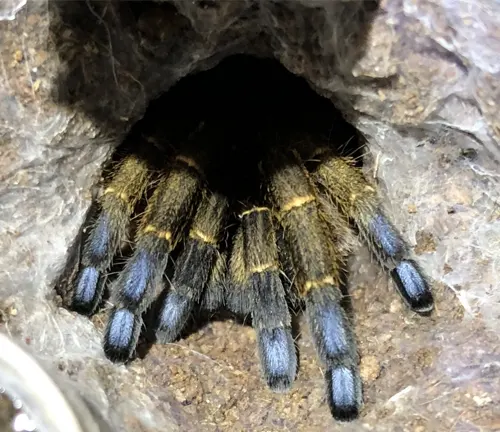
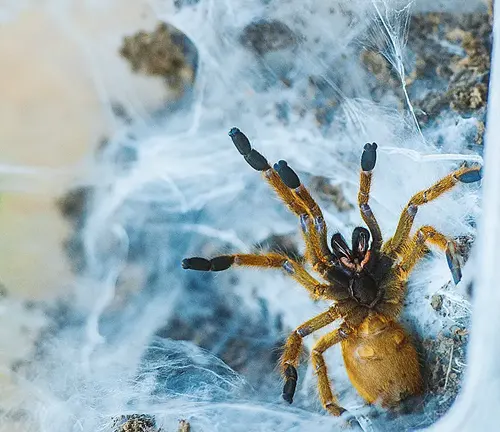
The behavior and lifestyle of the Blue Foot Baboon Tarantula are fascinating aspects of this species’ natural history. Here are some key points about their behavior and lifestyle:
- Solitary Nature: Blue Foot Baboon Tarantulas are solitary creatures, preferring to live alone in their burrows. They do not exhibit social behavior or form colonies like some other spider species.
- Nocturnal Activity: These tarantulas are primarily nocturnal, meaning they are most active during the night. They emerge from their burrows under the cover of darkness to hunt for prey and engage in other activities.
- Burrowing Behavior: Blue Foot Baboon Tarantulas are adept burrowers, constructing elaborate underground tunnels in the forest floor. They line their burrows with silk, which provides structural support and protection from predators.
- Hunting and Feeding: As ambush predators, Blue Foot Baboon Tarantulas rely on stealth and patience to capture their prey. They typically wait near the entrance of their burrows, sensing vibrations from passing insects, which they quickly snatch with their venomous fangs.
- Reclusive Demeanor: While Blue Foot Baboon Tarantulas are not aggressive towards humans, they are generally reclusive and prefer to avoid confrontation. When threatened, they may retreat into their burrows or use their venomous fangs as a last resort.
- Molting: Like all tarantulas, Blue Foot Baboon Tarantulas undergo molting to shed their old exoskeleton and grow. Molting is a vulnerable period for tarantulas, as they are soft and susceptible to injury until their new exoskeleton hardens.
- Longevity: Blue Foot Baboon Tarantulas have relatively long lifespans for arachnids, with females typically living longer than males. With proper care, they can live for several years in captivity.
Importance in Ecosystem
The Blue Foot Baboon Tarantula plays a significant role in the ecosystem of its native rainforest habitat. Here are some key points highlighting its importance:
- Predator of Insects: Blue Foot Baboon Tarantulas are voracious predators, feeding primarily on insects such as crickets, roaches, and beetles. By preying on these insects, they help regulate their populations, preventing them from reaching pest levels that could harm vegetation or disrupt ecological balance.
- Control of Prey Populations: As apex predators within their habitat, Blue Foot Baboon Tarantulas help control the populations of their prey species. By keeping these populations in check, they indirectly influence the abundance and distribution of other organisms within the ecosystem.
- Contribution to Nutrient Cycling: When Blue Foot Baboon Tarantulas consume prey, they not only regulate population sizes but also contribute to nutrient cycling within the ecosystem. The nutrients from consumed prey are recycled back into the environment through the tarantula’s excrement, enriching the soil and supporting plant growth.
- Biodiversity Maintenance: By occupying a niche as predators in the ecosystem, Blue Foot Baboon Tarantulas contribute to the maintenance of biodiversity. They are part of the intricate web of interactions between species within their habitat, playing a role in shaping the composition and dynamics of the ecosystem.
- Indicator of Ecosystem Health: The presence of Blue Foot Baboon Tarantulas can serve as an indicator of ecosystem health. Healthy populations of these tarantulas suggest the presence of suitable habitat conditions, including sufficient prey availability and habitat structure.
Conservation Status
The conservation status of the Blue Foot Baboon Tarantula is of concern due to various threats facing its natural habitat and population. While specific data on population trends and distribution are limited, the species faces several conservation challenges:
Habitat Loss and Fragmentation
The primary threat to Blue Foot Baboon Tarantulas is habitat loss and fragmentation caused by deforestation and land conversion for agricultural and development purposes. As rainforests in Mozambique continue to be cleared, the suitable habitat for these tarantulas diminishes, leading to population declines and fragmentation.
Illegal Collection for the Pet Trade
Blue Foot Baboon Tarantulas are sought after by collectors and enthusiasts in the exotic pet trade. Illegal collection from the wild poses a threat to wild populations, as it can deplete their numbers and disrupt natural ecosystems.
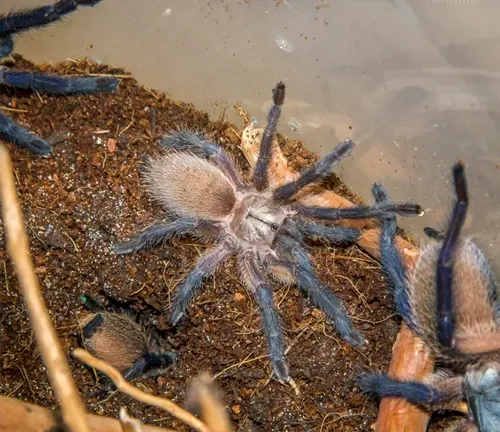
Climate Change
Climate change and its associated impacts, such as changes in temperature and precipitation patterns, can alter the habitat suitability for Blue Foot Baboon Tarantulas. Shifts in climate conditions may affect their ability to survive and reproduce in their native habitats.
Pollution
Pollution from agricultural runoff, logging activities, and urban development can degrade the quality of water and soil in Blue Foot Baboon Tarantula habitats, potentially impacting their survival and reproductive success.
Lack of Conservation Awareness
Limited public awareness and understanding of the importance of conserving Blue Foot Baboon Tarantulas and their habitats contribute to insufficient conservation efforts and inadequate protection measures.
Keeping Blue Foot Baboon Tarantulas as Pets
Keeping Blue Foot Baboon Tarantulas as pets can be a rewarding experience for enthusiasts willing to provide the specialized care these fascinating arachnids require. Here are some key considerations for successfully keeping Blue Foot Baboon Tarantulas as pets:
- Suitability: Blue Foot Baboon Tarantulas are best suited for experienced tarantula keepers due to their specific care requirements and handling sensitivity. They are not recommended for beginners who may not have the necessary experience to meet their needs.
- Enclosure: Provide a suitable enclosure for your Blue Foot Baboon Tarantula, such as a glass terrarium with secure lids to prevent escapes. The enclosure should have adequate ventilation and be large enough to accommodate the tarantula’s natural behaviors, including burrowing and climbing.
- Substrate: Use a substrate that mimics the tarantula’s natural habitat, such as a mixture of coconut fiber, peat moss, and vermiculite. The substrate should be deep enough to allow for burrowing and provide a comfortable and secure environment for the tarantula.
- Temperature and Humidity: Maintain appropriate temperature and humidity levels within the tarantula’s enclosure. Blue Foot Baboon Tarantulas thrive in warm and humid conditions, with temperatures ranging from 75°F to 85°F and humidity levels around 70% to 80%.
- Feeding: Offer a varied diet of live or pre-killed insects suitable for the size of your tarantula, including crickets, roaches, and mealworms. Feed your Blue Foot Baboon Tarantula 2-3 times per week, adjusting the feeding schedule based on its appetite and activity level.
- Water: Provide a shallow water dish filled with clean, non-chlorinated water for your tarantula to drink from. Mist the enclosure regularly to maintain humidity levels and ensure the substrate remains moist but not waterlogged.
- Handling: Limit handling of your Blue Foot Baboon Tarantula to minimize stress and reduce the risk of injury to both the tarantula and yourself. If handling is necessary, use gentle and cautious techniques, avoiding sudden movements or disturbances.
- Health Monitoring: Monitor your tarantula’s health regularly, observing its behavior, appetite, and appearance for any signs of illness or distress. Seek veterinary care from a qualified exotic animal veterinarian if you notice any concerning symptoms.
Common Misconceptions
There are several common misconceptions surrounding Blue Foot Baboon Tarantulas that are important to address for a better understanding of these fascinating arachnids. Here are some misconceptions debunked:
- Aggressiveness: One common misconception is that Blue Foot Baboon Tarantulas are aggressive and prone to biting. In reality, these tarantulas are typically docile and shy, preferring to retreat rather than confront threats. They are unlikely to bite humans unless provoked or mishandled.
- Toxicity: Another misconception is that the venom of Blue Foot Baboon Tarantulas is highly toxic and dangerous to humans. While they do possess venom for subduing prey, their venom is relatively mild and not considered harmful to humans. Bites from these tarantulas may cause mild irritation or discomfort but are not medically significant.
- Escape Artists: Some people believe that Blue Foot Baboon Tarantulas are skilled escape artists capable of quickly fleeing from their enclosures. While they are capable of climbing and may occasionally explore their surroundings, proper enclosure setup with secure lids can prevent escapes effectively.
- Difficulty of Care: Blue Foot Baboon Tarantulas are sometimes perceived as difficult to care for, requiring complex husbandry and specialized knowledge. While they do have specific care requirements, with proper research and understanding, they can be successfully kept as pets by experienced keepers.
- Size: There is a misconception regarding the size of Blue Foot Baboon Tarantulas, with some believing that they are much larger than they actually are. While females can reach sizes of up to 6 inches in leg span, males are typically smaller. Proper handling and husbandry techniques can help manage any concerns about size.
- Lifespan: Some individuals may believe that Blue Foot Baboon Tarantulas have short lifespans, leading to misconceptions about their longevity as pets. In reality, with proper care, these tarantulas can live for several years in captivity, providing companionship and enjoyment for their keepers.
Interesting Facts
- Blue Foot Baboon Tarantulas are known for their intricate web-spinning abilities, using silk to construct elaborate burrows and trap prey.
- Despite their intimidating appearance, these tarantulas are gentle giants, preferring to flee rather than fight when threatened.
Different Species
Cobalt Blue Tarantula
(Haplopelma lividum)
This tarantula species, native to Myanmar, is known for its vibrant cobalt blue coloration, particularly on its legs. It’s often considered one of the most strikingly colored tarantulas in the world.
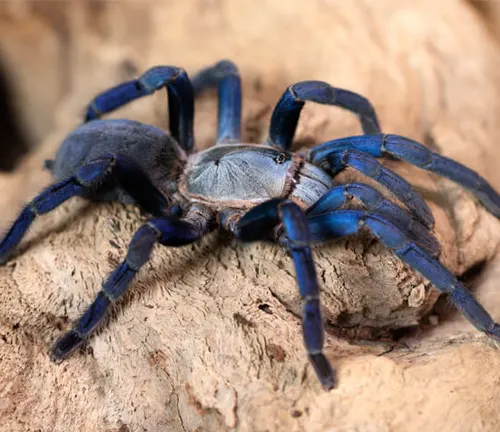
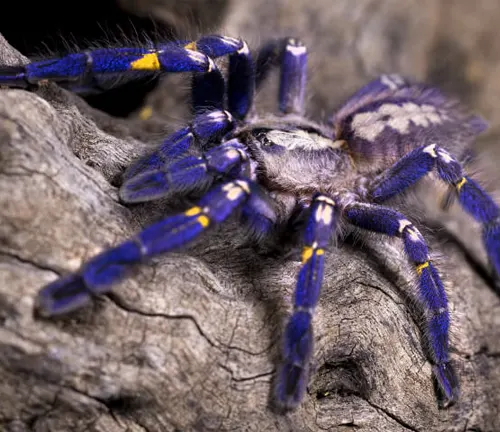
Gooty Sapphire Ornamental Tarantula
(Poecilotheria metallica)
Found in the forests of southern India, the Gooty Sapphire Ornamental Tarantula exhibits stunning metallic blue coloration on its legs and abdomen, making it highly sought after by tarantula enthusiasts.
Greenbottle Blue Tarantula
(Chromatopelma cyaneopubescens)
While not entirely blue, this tarantula species from Venezuela and Paraguay features bright blue legs and a metallic green carapace, giving it a visually striking appearance.


Cyan Blue Tarantula
(Lampropelma violaceopes)
Native to Malaysia and Thailand, the Cyan Blue Tarantula showcases deep blue coloration on its legs, contrasting with its dark body, creating an eye-catching appearance.
Singapore Blue Tarantula
(Lampropelma sp. “Borneo Black”)
Despite its name, this tarantula species, which originates from Malaysia and Indonesia, exhibits a dark blue or black coloration, particularly on its legs, giving it a unique and beautiful appearance.

Frequently Asked Questions (FAQs)
- Are Blue Foot Baboon Tarantulas venomous?
While Blue Foot Baboon Tarantulas possess venom to subdue their prey, their venom is considered mild and not harmful to humans. Bites from this species typically result in mild irritation or discomfort. - How long do Blue Foot Baboon Tarantulas live?
In captivity, Blue Foot Baboon Tarantulas can live for several years, with females often outliving males. On average, they may live anywhere from 5 to 10 years, depending on factors such as diet, habitat, and overall care. - Do Blue Foot Baboon Tarantulas require special housing?
Yes, Blue Foot Baboon Tarantulas require a suitable enclosure with adequate ventilation, substrate for burrowing, and hiding places. It’s essential to provide a secure habitat to prevent escapes and ensure the well-being of the tarantula. - Can Blue Foot Baboon Tarantulas be handled?
While Blue Foot Baboon Tarantulas are generally docile, handling should be avoided as it can stress the tarantula and increase the risk of injury or escape. It’s best to observe them from a distance and minimize disturbances. - How often should Blue Foot Baboon Tarantulas be fed?
Blue Foot Baboon Tarantulas should be fed appropriately sized prey items 2-3 times per week, depending on their size and appetite. It’s essential to monitor their feeding behavior and adjust their diet accordingly. - Do Blue Foot Baboon Tarantulas molt?
Yes, like all tarantulas, Blue Foot Baboon Tarantulas undergo molting to grow and replace their exoskeleton. Molting is a natural process and occurs periodically throughout their lives. - Are Blue Foot Baboon Tarantulas suitable for beginners?
Blue Foot Baboon Tarantulas are not recommended for beginners due to their specific care requirements and handling sensitivity. They are better suited for experienced tarantula keepers who can provide the necessary care and attention. - How can I sex Blue Foot Baboon Tarantulas?
Sexing Blue Foot Baboon Tarantulas can be challenging and often requires examination of the ventral side of the tarantula or professional assistance from experienced breeders or arachnologists. - What is the natural habitat of Blue Foot Baboon Tarantulas?
Blue Foot Baboon Tarantulas are native to the rainforests of Mozambique, where they inhabit burrows in the forest floor. They prefer warm, humid environments with plenty of hiding places. - Can Blue Foot Baboon Tarantulas be housed together?
Blue Foot Baboon Tarantulas are solitary creatures and should not be housed together, as they may exhibit cannibalistic behavior, especially during molting or breeding periods.


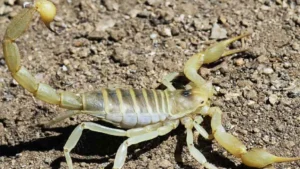

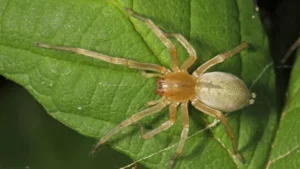
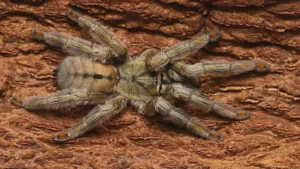
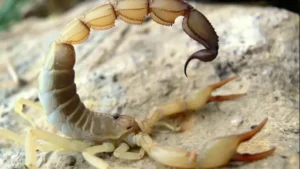
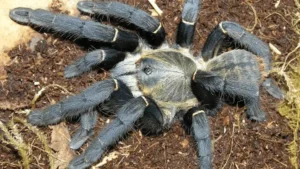

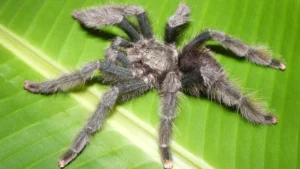

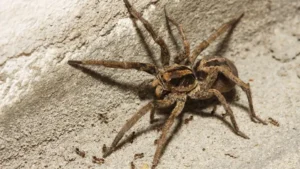


Leave your comment